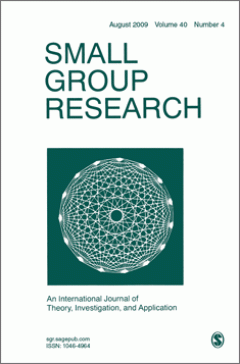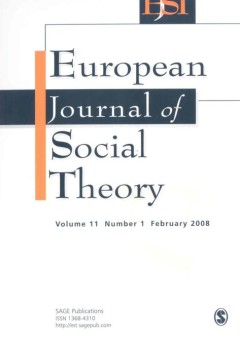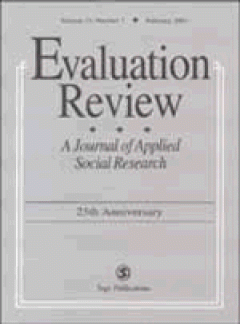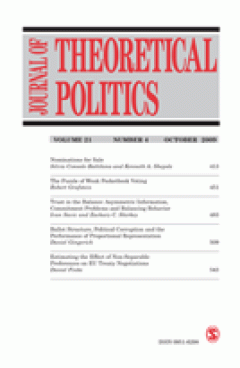Filter by

Modularizing Small Group Theories in Sociology
This article asserts that it is beneficial to formulate theories using methods specifically designed to facilitate and promote integrations. Although it is written using illustrations primarily from sociology, the discussion is relevant to other fields to whatever extent their theories may be deemed informal (i.e., presented without explicitly defined terms, distinct propositions, or logical ca…
- Edition
- Vol. 41 no. 6. December 2010.pp. 664-687
- ISBN/ISSN
- 10464964
- Collation
- -
- Series Title
- Small Group Research
- Call Number
- -

Modeling Ideational Creativity in Groups: Connecting Cognitive, Neural, and C…
Many creative activities take place in a group context, whether in short-term meetings, work teams, or by means of electronic interaction. The group creative process necessarily involves the exchange of ideas or information. Recent models of group creativity have focused on the cognitive underpinnings of this type of group creative process, primarily based on the group brainstorming literature.…
- Edition
- Vol. 41 no. 6, December 2010. pp. 688-724
- ISBN/ISSN
- 10464964
- Collation
- -
- Series Title
- Small Group Research
- Call Number
- -

A Multilevel Model of Transformational Leadership and Adaptive Performance an…
Using a multilevel framework, we hypothesized that (a) individual perceptions of transformational leadership and (b) team-level transformational leadership climate would be positively related to individual adaptive performance. We also hypothesized that a stronger climate for innovation would enhance the association between transformational leadership and adaptive performance at the individual …
- Edition
- Vol. 35 no. 6, December 2010.pp. 699-726
- ISBN/ISSN
- 10596011
- Collation
- -
- Series Title
- Group Organization Management
- Call Number
- -

Friends in Need: The Protective Effect of Social Relationships Under Low-Safe…
Previous studies have explored the role of social relationships, mainly with the supervisor, in promoting a high organizational safety climate. Not much is known, however, about the effect of social relationships when the safety climate is low. This study explored whether high-quality social relationships could compensate for a low level of safety climate. Hypotheses were tested among 673 emplo…
- Edition
- Vol. 35 no. 6, December 2010.pp. 727-750
- ISBN/ISSN
- 10596011
- Collation
- -
- Series Title
- Group Organization Management
- Call Number
- -

Team Self-Managing Behaviors and Team Effectiveness: The Moderating Effect of…
This study investigates the role of team members� self-managing behaviors in regard to three dimensions of team effectiveness. Furthermore, this study examines the moderating effect of task routineness on these relationships. The sample consists of 97 work teams (341 members and 97 immediate supervisors) drawn from a public safety organization. Results show that team self-managing behaviors are…
- Edition
- Vol. 35 no. 6. December 2010.pp. 751-781
- ISBN/ISSN
- 10596011
- Collation
- -
- Series Title
- Group Organization Management
- Call Number
- -

Effects of Team Size and Work Team Perception on Workplace Commitment: Eviden…
This study investigated the influence of production team size (small vs. large) and employees� perceptions of their production work teams (negative, neutral, and positive) on their level of workplace commitment.Twenty-three production work teams composed of 205 employees (105 males, 100 females), drawn from two team-based private manufacturing organizations, participated in the study. They resp…
- Edition
- Vol. 41 no. 6. December 2010.pp. 725-745
- ISBN/ISSN
- 10464964
- Collation
- -
- Series Title
- Small Group Research
- Call Number
- -

Deliberation and Diversity: Perceptions of Small Group Discussions by Race an…
One of the challenges facing public deliberation scholars and practitioners is to identify deliberative processes that address inequities in interaction and foster active participation among all members of ethnically or racially diverse groups. This study draws from cocultural communication theory and uses mixed methodology to examine the experiences of citizens assigned to racially/ ethnically…
- Edition
- Vol. 41 no. 6, December 2010.pp. 746-776
- ISBN/ISSN
- 10464964
- Collation
- -
- Series Title
- Small Group Research
- Call Number
- -

Mitteleuropa in East-Central Europe : From Helsinki to EU Accession (1975-2004)
The aim of this article is to provide a description, an analysis and an explanation of Mitteleuropa and of other closely related concepts, such as East-Central Europe. The first section briefly addresses the broad historiographical issues. The second addresses the more strictly political and intellectual history of the concept in the period between 1975 and 1989 while the third section wi…
- Edition
- Vol. 11, No. 2, Page 219-235
- ISBN/ISSN
- 1368-4310
- Collation
- -
- Series Title
- European Journal of Social Theory
- Call Number
- -

Quantitative Analysis of Verbal Expressions in Comments From Evaluation Commi…
This article discusses the quantitative analysis of verbal expressions of comments from the evaluation committee reviewers for 8 years (FY2001�FY2008) at the Japanese Public Research Institute, National Institute of Advanced Industrial Science and Technology (AIST). First, the terms often appearing in the comment sheets were observed. Moreover, gradually increasing terms every year and suddenly…
- Edition
- Vol. 34 no. 5, October 2010.pp. 419-435
- ISBN/ISSN
- 0193841x
- Collation
- -
- Series Title
- Evaluation Review
- Call Number
- -

Beyond and Below Racial Homophily: ERG Models of a Friendship Network Documen…
A notable feature of U.S. social networks is their high degree of racial homogeneity, which is often attributed to racial homophily�the preference for associating with individuals of the same racial background. The authors unpack racial homogeneity using a theoretical framework that distinguishes between various tie formation mechanisms and their effects on the racial composition of networks, e…
- Edition
- Volume 116. No. 2, September 2010.pp. 583-642
- ISBN/ISSN
- 00029602
- Collation
- -
- Series Title
- The American Journal of Sociology
- Call Number
- -

Settling Down and Aging Out: Toward an Interactionist Theory of Desistance an…
Conceptions of adulthood have changed dramatically in recent decades. Despite such changes, however, the notion that young people will eventually �settle down� and desist from delinquent behaviors is remarkably persistent. This article unites criminology with classic work on age norms and role behavior to contend that people who persist in delinquency will be less likely to make timely adult tr…
- Edition
- Volume 116. No. 2, September 2010.pp. 543-582
- ISBN/ISSN
- 00029602
- Collation
- -
- Series Title
- The American Journal of Sociology
- Call Number
- -

A Multilevel Systemic Model of Community Attachment: Assessing the Relative I…
To what extent does community context affect individuals� social ties and levels of community attachment? The authors replicate Sampson�s multilevel version of Kasarda and Janowitz�s systemic model of community using data from a survey of nearly 10,000 people residing in 99 small Iowa communities. They improve on Sampson�s work by using multilevel statistical tools, better measurement of commun…
- Edition
- Volume 116. No. 2, September 2010.pp. pp. 503-542
- ISBN/ISSN
- 00029602
- Collation
- -
- Series Title
- The American Journal of Sociology
- Call Number
- -

Three Worlds of Relief: Race, Immigration, and Public and Private Social Welf…
Using a data set of public and private relief spending for 295 cities, this article examines the racial and ethnic patterning of social welfare provision in the United States in 1929. On the eve of the Depression, cities with more blacks or Mexicans spent the least on social assistance and relied more heavily on private money to fund their programs. Cities with more European immigrants spent th…
- Edition
- Volume 116. No. 2, September 2010.pp. pp. 453-502
- ISBN/ISSN
- 00029602
- Collation
- -
- Series Title
- The American Journal of Sociology
- Call Number
- -

Industry Induces Academic Science to Know Less about More
How does collaboration between academic research and industry shape science? This article argues that companies' relative indifference to theory nudges their academic partners toward novel, theoretically unanticipated experiments. The article then evaluates this proposition using fieldwork, archival materials, and panel models of all academic research using the popular plant model Arabidopsis t…
- Edition
- Volume 116. No. 2, September 2010.pp. pp. 389-452
- ISBN/ISSN
- 00029602
- Collation
- -
- Series Title
- The American Journal of Sociology
- Call Number
- -

The Oncomouse That Roared: Hybrid Exchange Strategies as a Source of Distinct…
Conventional wisdom suggests that when institutional logics overlap, the production of hybrids signifies collapse, blending, or easy coexistence. The author provides an alternative interpretation: hybrids can maintain a distinctive boundary and can emerge from contestation, not coexistence. This alternative interpretation is grounded in an analysis of a critical moment at the academic?commercia…
- Edition
- Volume 116. No. 2, September 2010.pp. 341-388
- ISBN/ISSN
- 00029602
- Collation
- -
- Series Title
- The American Journal of Sociology
- Call Number
- -

How presidents push, when presidents win: A model of positive presidential po…
Presidents� positive role in US lawmaking is as ubiquitous as it is unclear. While a rich literature has identified many macro-level factors that constrain presidents� policymaking potential, still unanswered is Richard Neustadt�s micro-level question: how can presidents influence legislation given the context and Congress they happen to inherit? Developing a game theoretic model in which the p…
- Edition
- Vol. 23 no. 1, January 2011.pp. 3-20
- ISBN/ISSN
- 09516298
- Collation
- -
- Series Title
- Journal of Theoretical Politics
- Call Number
- -

Why primaries? The party’s tradeoff between policy and valence
Our theory studies why and when political parties choose to hold competitive primary elections. Party leaders can decide the nomination by granting resources and endorsements to a chosen candidate. Alternatively, they can delegate the candidate selection to the party�s rank and file by holding a primary election among multiple candidates. The benefit of a primary is to increase the expected val…
- Edition
- Vol. 23 no. 1, January 2011.pp. 21-51
- ISBN/ISSN
- 09516298
- Collation
- -
- Series Title
- Journal of Theoretical Politics
- Call Number
- -

Seizing the mantle of change: Modeling candidate quality as effectiveness ins…
In spatial models of electoral competition, candidate quality is typically modeled as valence, a measure of general appeal assumed to be constant across voters. This paper introduces and formally models an alternative conception of candidate quality according to which candidates differ in their effectiveness, or likelihood of changing policy from the status quo. Although more effective candidat…
- Edition
- Vol. 23 no. 1, January 2011.pp. 52-68
- ISBN/ISSN
- 09516298
- Collation
- -
- Series Title
- Journal of Theoretical Politics
- Call Number
- -

Optimal counterterrorism and the recruitment effect of large terrorist attack…
We analyze a simple dynamic model of the interaction between terrorists and authorities. Our primary aim is to study optimal counterterrorism and its consequences when large terrorist attacks lead to a temporary increase in terrorist recruitment. First, we show that an increase in counterterrorism makes it more likely that terrorist cells plan small rather than large attacks and therefore may i…
- Edition
- Vol. 23 no. 1, January 2011,pp. 69-86
- ISBN/ISSN
- 09516298
- Collation
- -
- Series Title
- Journal of Theoretical Politics
- Call Number
- -

Are group sources always credible? An experimental study of sources, stakes a…
When is mobilization of group identity successful? Work on social movements suggests that frames that target group identity can mobilize groups. However, this work does not address when group mobilization using frames is likely to be successful. Recent work on source credibility finds that same-group sources are an important moderator of framing effects, and previous work on stakes of the decis…
- Edition
- Vol. 23 no. 1, January 2011.pp. 87-110
- ISBN/ISSN
- 09516298
- Collation
- -
- Series Title
- Journal of Theoretical Politics
- Call Number
- -
 Computer Science, Information & General Works
Computer Science, Information & General Works  Philosophy & Psychology
Philosophy & Psychology  Religion
Religion  Social Sciences
Social Sciences  Language
Language  Pure Science
Pure Science  Applied Sciences
Applied Sciences  Art & Recreation
Art & Recreation  Literature
Literature  History & Geography
History & Geography